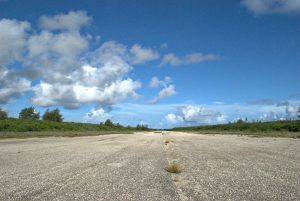The U.S. Air Force is still scouring the Pacific for new airfields, continuing a years-long effort to expand the number of locations it can operate from in order to complicate the Chinese military’s ability to target its forces in a future conflict.
The search includes military and civilian airfields that are less built-up than the Air Force’s main operating bases in the region, some of which will need upgrades to be usable, the senior U.S. Air Force commander in the Pacific told reporters last month.
Rather than building large new bases like Kadena Air Base in Japan or Andersen Air Force Base in Guam, “I see it more about locations” where the Air Force has permission for access, basing, and overflight when needed, Gen. Kevin Schneider, the commander of U.S. Pacific Air Forces, said during a media roundtable at an Air and Spaces Forces Association conference on February 13.
“There are a lot of airfields around the Pacific, some of them that haven’t been used in years, and we’re reclaiming and doing efforts to restore some of those,” Schneider said. “It helps us gain an ability to operate, whatever the environment, whatever the situation.”
Schneider echoed his predecessor, Gen. Kenneth Wilsbach, who said that throughout his tenure Pacific Air Forces was focused on expanding the number of airfields it could use and on improving its ability to use them by developing a concept known as agile combat employment, in which forces are able to deploy from larger “hub” bases on short notice while also operating from dispersed and austere “spoke” bases.
In November 2020, shortly after taking command, Wilsbach said the Air Force had “studied every single piece of concrete” in the Indo-Pacific theater to find locations that could support its aircraft. Since then, Pacific Air Forces has regularly carried out exercises in which aircraft have deployed from major bases in places like Japan and Alaska to less developed, more remote airfields across the Pacific, including on Tinian in the Northern Mariana Islands. Wilsbach said in September that the Air Force was upgrading two airfields on Tinian that were used to launch B-29 raids against Japan during World War II.
“There are some locations that we haven’t touched in years, some that go back to World War II construction that are being looked at, others that are currently used but probably need to be expanded in terms of their capability to support military operations,” Schneider told reporters at the conference, speaking just days after taking command of Pacific Air Forces.
“So it really runs the gamut of what we’re trying to get after in terms of expanding locations from which we can operate,” he added.
Expeditionary operations are not new for the U.S. Air Force, but the service has in recent years put more emphasis on being able to conduct them, particularly in situations where access to supplies and communications is limited or denied. The renewed focus is a response to the rapid expansion and growing reach of the Chinese military, which now fields a variety of cruise and ballistic missiles that U.S. officials expect to be fired at U.S. bases in large numbers early in a conflict.
The Air Force’s search for new outposts reflects the U.S. military’s wider effort to improve its footprint in the Western Pacific. Since late 2022, the Pentagon has reached agreements with allies in the region to expand U.S. access to their military facilities. The deals include air bases in northern Australia and an additional four sites in the Philippines, among them an air base north of Manila and an air base on the northern coast of Luzon, overlooking the sea south of Taiwan.
The U.S. also reached a defense cooperation agreement last year with Papua New Guinea, “which will allow access opportunities for the United States,” Ely Ratner, the assistant secretary of defense of Indo-Pacific affairs, said in a recent podcast interview. “We are already doing site surveys and thinking about investments in port and airfields there,” Ratner added.
Discussions about access are “an ongoing dialogue,” Schneider said at the conference, citing Japan and the Philippines as countries where such efforts have “really progressed” since the mid-2010s.
Schneider said that as he spoke, Brig. Gen. Brian Laidlaw, the director of strategy, plans, programs, and requirements at Pacific Air Forces, was in the region “having face-to-face conversations in a couple of locations to further expand our ability to move around the theater and to do what we need to do and to build those relationships.”

































